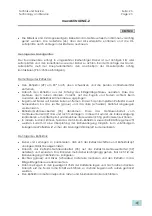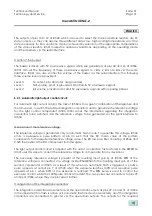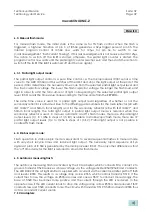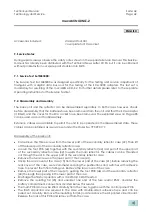
Technik und Service
Seite: 37
Technology and Service
Page: 37
mecablitz 40 MZ-2
ENGLISH
The outputs at pins 13 to 19 of IC504, which are used to select the Canon aperture resistors, are tri-
state outputs, i.e. they can assume three different states: low, high and high-impedance. All of the
states necessary for SCA contact 6 can be achieved by selection of the appropriate combinations
of the various resistors. IC301 makes the necessary selections, depending on the operating mode
and the aperture, via the serial interface.
Control of the buzzer:
The buzzer is driven with 5V squarewave signals which are generated at pins 40 and 41 of IC504.
IC301 can set the frequency of these squarewave signals to 1 kHz, 2 kHz or 4 kHz via the serial
interface. IC301 can also control the volume of the buzzer via the serial interface; the following
three volume levels are provided:
Level 0:
no output, pins 40 and 41 are grounded
Level 1:
half volume, pin 41 is grounded, pin 40 emits 5V squarewave signal
Level 2:
full volume, pins 40 and 41 emit 5V squarewave signals with opposing phases
5.2.1. Automatic light output control circuit:
For automatic light output control, the task of IC504 is, for a given combination of the aperture and
the film speed, to switch the related integration capacitors and to generate the reference voltage
for the light control comparator IC503. IC301 sends the information regarding the integration
capacitors to be switched and the reference voltage to be generated via the serial interface to
IC504.
Generation of the reference voltage:
The reference voltage is generated only in automatic flash mode. To generate this voltage, IC504
emits a squarewave pulse pattern at pin 33 such that the DC mean value of the pattern
corresponds to the required reference voltage value. The RC low-pass filter consisting of R546 and
C525 then extracts the DC component from this signal.
The light output control circuit is adjusted with the aid of a correction factor stored in the EEPROM.
IC301 uses this value to correct the reference voltage to compensate for any deviations.
The necessary reference voltage is present at the inverting input (pin 6) of IC503. 80% of the
reference voltage is connected via voltage divider R544/R545 to the inverting input (pin 2) of the
second comparator in IC503. As a result of this, when an automatic flash is triggered, a positive
pulse appears at output pin 7 of IC503 when the exposure reaches 100% and a positive pulse
appears at pin 1 when 80% of the exposure is reached. The 80% pulse is used to control the
exposure control, while the 100% pulse controls the IGBT. The two pulses are connected to pins 25
and 26 of IC504, where they are processed further.
Configuration of the integration capacitors:
The integration capacitors are selected via the open-drain outputs at pins 29, 30 and 31 of IC504.
In the idle state (if no flash is active or if automatic flash mode is not selected), all of the integration
capacitors are connected to ground via the open-drain outputs. The outputs for the required





















